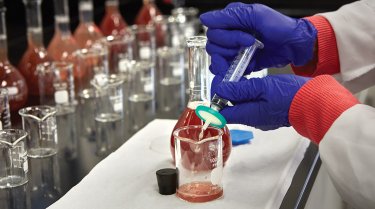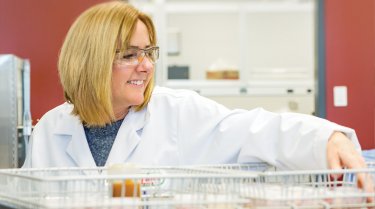
Driving down a nondescript industrial road in Austin, Minn., you might find yourself slowing down to admire a striking building with a facade of glass and red panels. Backing onto Wolf Creek and a forest of white oak and ironwood trees, it would be easy to mistake the building for a high-end architectural firm. Instead, this is the new multimillion dollar, 52,000-square-foot research and development laboratory of Hormel Foods.

Inside, everything feels new. Sun streams into large open workspaces. But don’t let calm, stylish surroundings fool you. The microbiologists and chemists perform a herculean amount of work in this new facility. Every year, more than 800,000 tests are performed. Weighing anywhere from 2 ounces to 80 pounds, the samples tested come from up and down the supply, processing and distribution chains, and typically include everything from ingredients to the final packaged product. The testing is serious and meticulous, and that’s as it should be. This rigorous process is at the heart of the commitment of Hormel Foods to provide consumers with safe and nutritious food.
Despite the workload, the vibe inside the R&D building is calm and workmanlike. In the heart of the facility, microbiologists and chemists in white lab coats run a variety of tests and assays. As the names suggest, the microbiology lab focuses on general microbiological and pathogen testing, while the chemistry lab focuses on chromatography and general chemistry analysis. The work requires top-of-the-line equipment that must be constantly tested and calibrated.
“We’re able to collaborate on projects with many areas of the company because we have everything we need here,” said Sally Staben, manager of the chemistry and microbiology labs. “We can help bring new products to life, working with product developers, marketers and package designers.”

In 2017, the lab earned the coveted ISO/IEC 17025 accreditation, a critical accomplishment for any lab. Simply put, adherence to the standard demonstrates the lab’s technical competence. According to R&D lab administrator Marco Garcia, the nearly yearlong process culminated with a two-day on-site inspection. “This accreditation is the gold standard for labs,” Garcia said. “It has been a huge team effort. All 45 of us in the R&D building pitched in. It also took a great deal of support from others in the company. It’s proof that Hormel Foods really believes in the functions this lab provides.”
Consumers increasingly want simple, easily understandable ingredients in their food. Hormel Foods has responded by removing or reducing additives and preservatives. In 2017 alone, the company initiated seven simplified ingredients projects, and six were completed. Those completed in 2017 included Hormel® Natural Choice® snacks and Stagg® chili.
Making Changes
But changing a recipe or the packaging of a food product that will eventually feed millions of people is no simple task. Any change in the ingredients – reducing salt, for instance – means the product has to be carefully tested to ensure the food is safe when it leaves the processing facility, plus during transportation, on the store shelf and over time in the homes of consumers.
The same goes for any changes in packaging. The team at Hormel Foods aggressively looks for ways to reduce packaging material in order to cut back on waste. But before new packaging can become a reality, it must pass a challenge test at the R&D lab. The product and package must pass the company’s rigorous testing protocol to be approved for production.
“What we do is intentionally introduce a pathogen or spoilage bacteria to a test sample of the product and repackage it,” said Aaron Asmus, director of food safety validation and laboratory services. “Then we hold it for the shelf life of the food and then test it. We have developed certain failure criteria in regard to both the rate of growth and extent of growth of these bacteria that the product must achieve in order for it to pass.”
Hormel Foods doesn’t shy away from investing in new technology
Dove Mullins, chemistry lab manager
In another part of the lab, the focus is on nutrition. Consumers are increasingly reading labels and rightfully expect the vitamin, carbohydrate and protein measures to be accurate. In addition, they may want to avoid allergens, various types of fats and other ingredients. Measuring these properties accurately is not an easy task, but technology saves the day. Tools such as an inductive coupled plasma mass spectrometer have the ability to separate parts of any food product on a molecular level, ensuring the packages’ nutritional information and product claims are accurate.
“Hormel Foods doesn’t shy away from investing in new technology,” said Dove Mullins, chemistry lab manager, demonstrating the workings of the mass spectrometer. “Of course, technology is only as good as the team that runs it. Fortunately, we have a great team here.”

Hormel Foods has had a food safety lab for nearly 80 years, and that’s allowed the company to pioneer ways to cook and package food for the world’s growing population. While changes in the food industry continue to accelerate, Asmus believes Hormel Foods will keep innovating the preparation and packaging of food. The company will also evaluate scientific advances, including new technology that can rapidly identify pathogens from their DNA.
On a wall in the lobby of the R&D facility is a quote from Albert Einstein that reads, “To raise new questions, new possibilities, to regard old problems from a new angle, requires creative imagination and marks real advance in science.” Einstein’s quote should hit a chord for any Hormel Foods team member. The sentiment lines up nicely with company patriarch George A. Hormel’s most famous admonition: “Originate, don’t imitate.”
This article was featured in Issue VII of Inside Hormel Foods magazine. Click here to explore these unique collections of thought-provoking and heartwarming stories, recipes and features on our employees and the different areas of our company, all packaged up in a beautifully designed digital viewer for you.